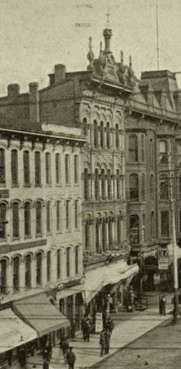Rood Building
The Rood Building is a commercial building in Grand Rapids, Michigan, listed on the National Register of Historic Places. It was built in 1873 for Charles Conant Rood, after whom the building is named.
Rood Building | |
 Rood Building in 2014 | |
| Location | 139 Pearl Street, NW, Grand Rapids, Michigan[1][lower-alpha 1] |
|---|---|
| Coordinates | 42.9666°N 85.6717°W |
| Built | 1873 |
| Architect | William G. Robinson |
| Architectural style | High Victorian Gothic[2] |
| NRHP reference No. | 88000142[3] |
| Added to NRHP | March 4, 1988 |
History

The Rood Building was built in 1873 for attorney and investor Charles Conant Rood. It replaced a three-story building at the site, also owned by Rood, which had burned down in October 1872. It was designed by Grand Rapids architect William G. Robinson.[4] Over the years, the building's tenants have generally consisted of offices or residences and at least one restaurant.[5]
The building underwent renovations in the 1980s,[6] which included the installation of a wooden replica cornice[7] and an addition that filled in the angle of the building's original "L" shape.[8] The building was added to the National Register of Historic Places on March 4, 1988.[1]
Architecture
The Rood Building is a four-story timber frame structure clad in brick.[1] It is the only surviving High Victorian Gothic commercial building in Grand Rapids and one of only a few High Victorian buildings in the city.[2]
The building originally had an "L"-shaped layout; the head of the "L" formed the narrow facade on Pearl Street and the foot of the "L" had a couple storefronts on a former pedestrian walkway.[8] An addition built in the 1980s filled in the angle of the "L" and houses an elevator and stairwell.[8][7]
The Pearl Street facade is divided into three bays; the central bay is three windows wide and the two narrower bays on each side have one window each.[8] The facade is topped by a large cornice bearing the year of construction, 1873. The cornice was originally made of iron, but it deteriorated and the last part was removed by the late 1970s; it was replaced with a replica made of painted wood.[7]
Notes
- The property is listed as "Address Restricted" in the NRIS database
References
- Staff. "Rood Building". State Historic Preservation Office. Michigan State Housing Development Authority. Archived from the original on July 7, 2013. Retrieved May 12, 2013.
- Reclofs 1988, Section 8, p. 3.
- "National Register Information System". National Register of Historic Places. National Park Service. March 13, 2009.
- Reclofs 1988, Section 8, p. 1.
- Reclofs 1988, Section 8, p. 2.
- Reclofs 1988, p. 29.
- Reclofs 1988, Section 7, p. 2.
- Reclofs 1988, Section 7, p. 1.
Bibliography
- Reclofs, Barbara L. (March 4, 1988). "National Register of Historic Places Inventory/Nomination: Rood Building" (pdf). National Park Service. Cite journal requires
|journal=(help)CS1 maint: ref=harv (link)
External links
